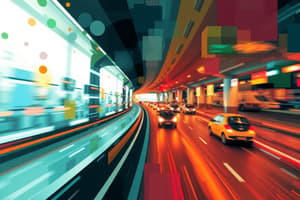Podcast
Questions and Answers
What are some functionalities of V2V communication mentioned in the text?
What are some functionalities of V2V communication mentioned in the text?
- IoT advancements and cloud computing
- Route optimization and predictive maintenance
- Cybersecurity threats and privacy concerns
- Lane changing assistance and platooning (correct)
How does real-time data analysis contribute to ITS according to the text?
How does real-time data analysis contribute to ITS according to the text?
- By focusing on large-scale adoption
- By deriving meaningful insights from vehicle data (correct)
- By increasing cybersecurity threats
- By addressing privacy concerns
What is a key role of real-time data analysis in traffic management?
What is a key role of real-time data analysis in traffic management?
- Optimizing routes based on data insights (correct)
- Enhancing large-scale adoption of technologies
- Predicting future cybersecurity threats
- Increasing privacy concerns
What are some challenges faced by ITS according to the text?
What are some challenges faced by ITS according to the text?
In the context of V2V communication, what does 'platooning' refer to?
In the context of V2V communication, what does 'platooning' refer to?
How does future research in ITS aim to enhance the technology?
How does future research in ITS aim to enhance the technology?
What is the primary objective of Intelligent Transportation Systems (ITS)?
What is the primary objective of Intelligent Transportation Systems (ITS)?
What technology is crucial for efficient traffic management in ITS?
What technology is crucial for efficient traffic management in ITS?
How do machine learning algorithms contribute to traffic management in ITS?
How do machine learning algorithms contribute to traffic management in ITS?
What does Vehicle-to-Vehicle (V2V) communication enable vehicles to share?
What does Vehicle-to-Vehicle (V2V) communication enable vehicles to share?
Which of the following is a benefit of Vehicle-to-Vehicle (V2V) communication?
Which of the following is a benefit of Vehicle-to-Vehicle (V2V) communication?
Flashcards
ITS Definition
ITS Definition
Applying advanced tech to improve surface transportation safety and efficiency.
ITS Objectives
ITS Objectives
Improve accessibility, sustainability, growth, and safe traffic flow.
Traffic Management
Traffic Management
Using tech to optimize transportation networks and manage traffic.
Real-time Traffic Information
Real-time Traffic Information
Collecting and using current traffic info to manage vehicles effectively.
Signup and view all the flashcards
Vehicle-to-Vehicle (V2V) Communication
Vehicle-to-Vehicle (V2V) Communication
Direct communication between vehicles sharing critical data.
Signup and view all the flashcards
V2V Data
V2V Data
Sharing data like position and speed to prevent collisions.
Signup and view all the flashcards
Forward Collision Alerts
Forward Collision Alerts
Alerts that warn drivers of potential forward collisions.
Signup and view all the flashcards
Platooning
Platooning
Grouping vehicles to travel closely together, improving efficiency.
Signup and view all the flashcards
Real-time Data Analysis
Real-time Data Analysis
Using data for smart decisions and resource management.
Signup and view all the flashcards
Benefits of Real-time data analysis
Benefits of Real-time data analysis
Using data to manage traffic, optimize routes and predict when something needs maintenance before failure.
Signup and view all the flashcards
ITS Challenges
ITS Challenges
Privacy, security, and wide adoption.
Signup and view all the flashcardsStudy Notes
Intelligent Transportation Systems: Traffic Management, Vehicle-to-Vehicle Communication, and Real-Time Data Analysis
Introduction
Intelligent Transportation Systems (ITS) encompass the application of advanced sensors, computers, electronics, and communication technologies to improve the safety and efficiency of surface transportation. The primary objectives of ITS are improving accessibility, enhancing environmental sustainability, fostering economic growth, and ensuring efficient and safe traffic flow.
Traffic Management
Traffic management is a core aspect of ITS, involving the use of IoT infrastructures and information and communication technologies (ICT) to optimize transportation networks. This includes the implementation of machine learning algorithms to gather, process, and disseminate real-time traffic information, enabling effective regulation, control, and management of vehicular traffic. Efficient traffic management systems can reduce congestion, enhance safety, and increase productivity across transportation systems.
Vehicle-to-Vehicle Communication
Vehicle-to-Vehicle (V2V) communication is another important element of ITS. V2V technologies facilitate direct communication between vehicles, allowing them to share vital information like position, velocity, and acceleration. This exchange of data helps prevent potential collisions by providing early warning systems, such as forward collision alerts. V2V communication also extends beyond safety applications, offering various functionalities like platooning, cooperative adaptive cruise control, and lane changing assistance.
Real-time Data Analysis
Real-time data analysis plays a pivotal role in ITS, enabling efficient decision-making and resource allocation. With advancements in machine learning, IoT, and cloud computing, vast amounts of data generated from vehicles and infrastructure can be collected, processed, and analyzed to derive meaningful insights. Real-time data analysis helps in responsive traffic management, route optimization, predictive maintenance, and condition monitoring.
Challenges and Future Directions
Despite the numerous advantages offered by ITS, it faces several challenges, including privacy concerns, cybersecurity threats, and the need for large-scale adoption and integration. Future research should address these hurdles and explore innovative ways to enhance the scalability, security, and usability of ITS.
In conclusion, Intelligent Transportation Systems represent a promising step towards smarter and safer surface transportation, integrating advanced technologies to achieve improved efficiency, safety, and sustainability.
Studying That Suits You
Use AI to generate personalized quizzes and flashcards to suit your learning preferences.




